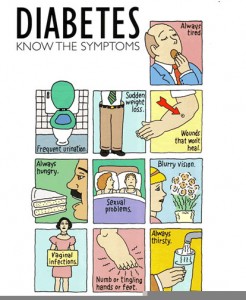Diabetes mellitus (DM), one of the most widespread diseases, is a common endocrine disorder that affects an estimated 16 million Americans and these numbers are increasing substantially. Individuals with diabetes face shortened life spans and have the probability of developing acute and chronic health complications. Only heart disease and cancer kill more Americans than diabetes and its complications.
Probably at least 50% of diabetics with mild or early disease pass unrecognised and this proves most unfortunate since early and continued treatment can help prevent some of the disastrous consequences of DM. These consequences can range from blindness, to amputations of limbs, gum disease, kidney failure, high blood pressure, nerves disorders, heart disease and a large reduction in the quality of life. The mouth is also part of the many parts of the organs of the body affected by DM.
Before we continue on to the main topic on how diabetes can affect your oral health, let us lay down some facts about the endocrine disorder.
What is diabetes mellitus?
Diabetes mellitus is actually a group of disorders characterized by the following:
- Insufficient supply of insulin because of either a lack of production by the pancreas, a deficit of insulin receptors or an error in insulin metabolism (insulin resistance)
- The body’s ability to metabolize carbohydrates, fats and proteins is impaired
- Resulting abnormalities in the structure and function of blood vessels (microangiopathy) and nerves (neuropathy)
The result of diabetes is hyperglycemia, a condition of abnormally increased blood glucose.
Categories of diabetes mellitus
1)Â Â Â Â Â Diabetes Mellitus
a)     Type 1 or Juvenile onset (insulin-dependent) diabetes – typically appearing before the age of 25, there is pancreatic beta-cell destruction usually leading to absolute insulin deficiency. Approximately 5-10% of the cases of diabetes are in this category. It can be:
i)Â Â Â Â Â Â Â Immune mediated (caused by attack by own body antibodies)
ii)Â Â Â Â Â Â Idiopathic (unknown cause)
b)     Type 2 or Maturity onset diabetes – typically appearing in people who are over middle age, relatively inactive and obese; there is insulin resistance with relative insulin deficiency or insulin secretion defect with insulin resistance. Approximately 90-95% of the cases fall into this category.
2)Â Â Â Â Â Other specific types
a)Â Â Â Â Â Other type of diabetes associated with certain conditions or syndromes: pancreatic disease, disorders of the endocrine glands, infections, chemical- or drug-induced disease, genetic defects, genetic syndromes, insulin-receptor abnormalities and others
b)     Gestational diabetes mellitus – any degree of glucose intolerance during pregnancy
c)      Impaired glucose tolerance (IGT) and impaired fasting glucose (IFG) – metabolic stages intermediate between normal glucose metabolic equilibrium and diabetes
What causes diabetes mellitus?
Most food eaten is digested into glucose, the main source of energy, which passes from the stomach and intestine into the blood. Glucose is able to pass into cells with the help of insulin, a hormone produced by the pancreas.
Diabetes mellitus is a disorder caused by an absolute or relative lack of insulin therefore there can be a low output of insulin from the pancreatic beta cells, or resistance of insulin from the surrounding tissues. If insulin has its action blocked or is insufficient, glucose cannot enter cells and without energy, weakness results. Glucose also accumulates to toxic levels in the blood (hyperglycemia) and spills over into the urine (glucosuria), taking with it, osmotically a large amount of water (polyuria).
Warning signs of diabetes mellitus
Type 1 diabetes is characterized by the sudden appearance of:
- frequent urination,
- frequent urge to drink,
- frequent urge to eat,
- weakness and tiredness,
- dramatic weight loss,
- irritability,
- nausea and vomiting
Type 2 diabetes is characterized by slow onset and includes any other type of the type 1 symptoms and/or:
- recurring or hard-to-heal skin,
- gum or bladder infections,
- blurred visions, tingling or numbness in hands or feet,
- itching
When should you test for diabetes mellitus?
 Testing for diabetes should be considered when you are at age 45 years and above and if found to be normal should be repeated at every 3 years. However testing should be considered at a younger age or be carried out more frequently in those who:
Testing for diabetes should be considered when you are at age 45 years and above and if found to be normal should be repeated at every 3 years. However testing should be considered at a younger age or be carried out more frequently in those who:
- Are overweight (≥120% desirable weight or a BMI≥27kg/m2)
- Have 1st degree relatives with diabetes, such as a parent or siblings
- Are members of a high-risk ethnic population (for example African American, Hispanic American, Native American, Asian American, and Pacific Islander)
- Have delivered a baby weighing >9lb or have been diagnosed with gestational DM
- Are hypertensive (having high blood pressure of ≥140/90)
- Have an high-density lipoprotein (HDL) cholesterol level ≤35mg/dl (0.90 mmol/L) and/or a triglyceride level ≥250mg/dl (2.82mmol/L)
- On previous testing, had IGT or IFG
To be continued in Part 2.



Pingback: Chronic Adult Periodontitis: Cause and Symptoms | Intelligent Dental
Pingback: How does dry mouth causes fatigue | Intelligent Dental
Pingback: Tweets that mention How Diabetes Can Affect Your Oral Health Part 1 | Intelligent Dental -- Topsy.com
Pingback: How Diabetes Can Affect Your Oral Health Part 2 | Intelligent Dental
Pingback: Oral health Pt 1: Why is it so important? | Intelligent Dental
Great information! I’ve been looking for something like this for a while now. Thanks!
Pingback: Oral Health Pt 3: Importance of saliva | Intelligent Dental
Pingback: How to Recognize Gingivitis Symptoms | Intelligent Dental